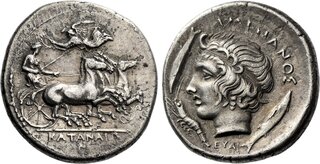| Numismatica Ars Classica > Auction 146 | Auction date: 8 May 2024 |
| Lot number: 2073 Price realized: This lot is for sale in an upcoming auction - Bid on this lot  | Show similar lots on CoinArchives Find similar lots in upcoming auctions on |
| Lot description: Catana. Drachm signed by Euainetos circa 405, AR 18 mm, 4.10 g. KATANAIΩ[N] Fast quadriga driven r. by charioteer, holding kentron and reins; above, Nike flying l. to crown him. Rev. Diademed head l. of river-god Amenanos; at either side, two fish and below chin, crayfish. Above, AMENANOΣ and beneath neck truncation, EYAI. Rizzo pl. 14, 7 (these dies). SNG Lloyd 907 (these dies). AMB 335. Kraay-Hirmer 38. SNG ANS 1263. Very rare and in exceptional condition for the issue, undoubtedly among the finest specimens known. A portrait of enchanting beauty, the work of a celebrated and skilled master-engraver. Perfectly centred on a very large flan and with a lovely light iridescent tone. Extremely fine Ex NFA XXV, 1990, 18 and NAC 9, 1996, 146 sales. Catana was founded at the foot of Mount Aetna by Chalkidian Greek colonists from Sicilian Naxos in c. 729 BC. Despite the prosperity of the city and a reputation for moral uprightness that developed in the seventh and sixth centuries BC, the Catanians frequently came into conflict with the Dorian Greek cities of Sicily, and especially Syracuse. In 476 BC, the Syracusan tyrant Hieron I expelled the Catanians from their city and repopulated it with Dorian Greek colonists. Following the death of Hieron, the dispossessed Catanians returned in 461 BC and violently reclaimed their own homes from the Dorian interlopers. The Catanians never forgot (or forgave) what had been done to them and continued to nurse a grudge against Syracuse, even going so far as to join Leontini-another traditional enemy of Syracuse-in supporting the disastrous Athenian expedition against Syracuse in 415-413 BC. Despite Catanian hatred for Syracuse, this beautiful drachm clearly illustrates the ultimate inability of Syracusan enemies to avoid becoming caught up in the growing cultural and economic influence of the great Sicilian city at the close of the fifth century BC. The Syracusan victory over the Athenians brought the city great wealth in plundered silver and brought about a period of numismatic art that had never been seen before. The engravers of this period were true artists who delighted in experimentation to bring the classical style to the height of perfection. As such, they took great pride in their work and regularly signed the dies they created for use at Syracuse and at other cities. Here the reverse die has been signed by Euainetos, an artist who is perhaps most famous for his later Syracusan decadrachm dies. It depicts Amenanos, the river-god of Catana, surrounded by two fish and a crayfish. This arrangement reflects the influence of Syracusan coins featuring the head of Arethusa surrounded by dolphins. The fast quadriga on the Catanian drachm is also very similar to that found on Euainetos' decadrachm die, including the horse with the broken rein. Estimate: 60000 CHF |  |



